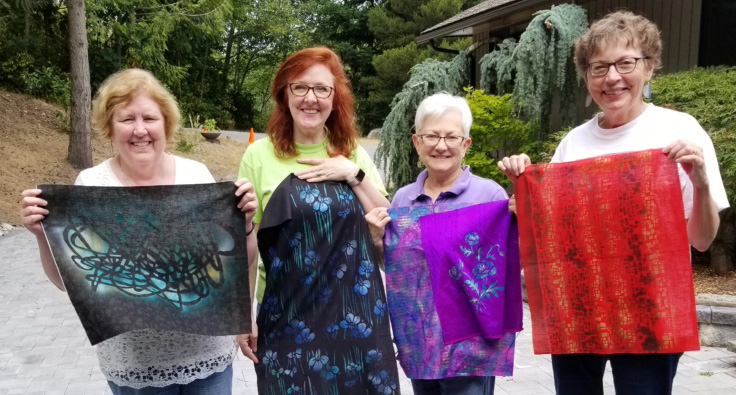Last night I attended the preview party for the 2018 Quilt and Fiber Art Festival in Everett, WA. With all the wonderful entries in this large International show, I’m awestruck and so humbly honored… I won 4 awards!
A Best of Show-Mixed Techniques Award Of Excellence for the show, “In Klimt’s Corral”
3rd place for Fiber Art- Mixed Media, “In Klimt’s Corral”
2nd place for Fiber Art- 3D/Sculptural, “Bullkelp Vessel”
2nd place for Fiber Art- Needlework, “Crested Serpent Eagle”
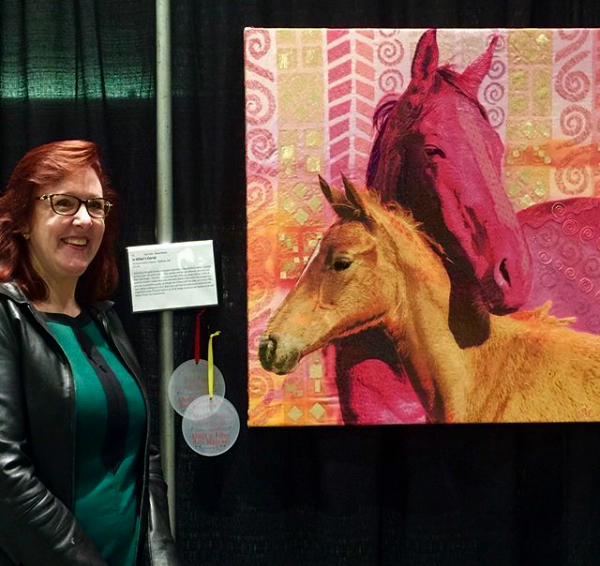
 “In Klimt’s Corral” will be included in the “Award Winners: Quilt and Fiber Arts Festival 2018” exhibit at the Pacific Northwest Quilt & Fiber Art Museum from October 17 – November 18, 2018.
“In Klimt’s Corral” will be included in the “Award Winners: Quilt and Fiber Arts Festival 2018” exhibit at the Pacific Northwest Quilt & Fiber Art Museum from October 17 – November 18, 2018.
Meanwhile, I’ll be scooping up the Bullkelp Vessel and Crested Serpent Eagle pieces to include in my exhibition later this month at the La Conner Country Inn. I’m still working feverishly to finish up all my pieces for that exhibit. I haven’t even taken time to count them all up, but I think I have about 30 pieces. I’ve continued to work many of my pieces to my theme of “the Water’s Edge”, coinciding with all the work I did on seaweeds during my 2 year Level 3 Art & Design class.

“Bull Kelp Forest Vessel” – 2nd place Fiber Art 3D / Sculptural by Christina Fairley Erickson
I want to thank my family for all the support they’ve given me as I continue on my fiber artist journey. I was so happy have my Mom, husband Randy, and daughter-in-law Zeyneb with me at the preview party last night, and I look forward to our other kids coming to my Advanced Stitch Exhibition. I have to give extra acknowledgement to Randy for putting up with my constant stitching or other work while we spend time together as well as having my art supplies stretching into all corners of our house! I appreciate all the support from both family and friends.

Mom Nan Cerini-Lopis and husband Randy Erickson at the Preview Party – 2018 Quilt & Fiber Art Festival

Christina with her “Crested Serpent Eagle” -2nd Place for Fiber Arts-Needlework and her piece “Fern Frond”
As many of you know, I have been studying at the Gail Harker Center for Creative Arts for some time… I believe it’s 8 years now. I’m just finishing 2 1/2 years in the Level 3 Advanced Experimental Stitch course. Our class will be exhibiting coursework including assessment items, sketchbooks, presentation books, samples, and historical stitch studies at an exhibition on October 26-27.

Mark your calendars! We will also have an artist talk from 10:30-11:30 am on Saturday October 27.
UK Textile Tour Day 9: Audrey Walker at the Ruthin Craft Centre – Wales
One week before I was scheduled to leave on my trip, I received my “Embroidery” magazine, the publication from the UK’s Embroiderers’ Guild. To my surprise, an article highlighted an upcoming exhibition at the Ruthin Craft Centre in Northern Wales of Audrey Walker’s amazing embroideries. And it was opening one day after I was scheduled to drive North through Wales up to Scotland!

Christina Fairley Erickson with Audrey Walker’s “Adam” and “Eve” stitched textiles (2000) and drawing study for “Eve”. Adam and Eve each approximately 16″ w x 40″ high (the embroidery). On loan by Graham Holland.
As an artist who does a lot of pictorial work, I’ve been a fan of Audrey Walker’s work ever since my mentor and tutor, Gail Harker, introduced me to Audrey’s intricate stitched portraits. So, without much hesitation, I worked out a change in my itinerary to stay an extra day in Wales, so I could see the exhibition on its opening day.

Detail from “Eve” by Audrey Walker 2000.
Audrey Walker’s six-decade long career in embroidery has influenced many contemporary embroiderers. Not only is she an amazing artist in her own right, she succeeded Constance Howard as the head of the Goldsmith’s College Embroidery & Textiles Department (1975-88) guiding another generation of makers. She focused on teaching her students to seek out and explore their ideas first, then to study the history and techniques to realize their artistic vision. Her first textile associate was Jan Beaney, who went

“The White Tulips” by Audrey Walker 2012 (approximately 48″ h x 16″ w). On loan from the Embroiderers’ Guild UK
on to become internationally renowned for her stitchwork, as well as being one of the Cities and Guilds tutors and evaluators who taught Gail Harker. So, I guess I can claim Audrey is my embroidery great-grandmother!

Detail from “The White Tulips” 2012 by Audrey Walker
This exhibition, in Audrey’s 90th year, is a retrospective of her work, with pieces coming from as far away as the U.S. (owned by private collectors) brought together at the Ruthin Craft Centre, the location of Audrey’s first solo exhibition 18 years ago.
Audrey’s start in textiles began ten years after completing her degree in fine art (mainly portrait painting), after seeing an exhibit of fabric collages by Margaret Kaye (1912-2002). Prior to that , Audrey associated embroidery with the domestic textiles of her youth. Rather than continuing on as a painter, textiles became Audrey’s medium of choice. She even incorporated some of her family’s domestic textiles into her artwork, giving a nod of recognition to the historic roots of embroidery.

“A Cumbrian Birthday” 1997/8 by Audrey Walker uses a tray cloth from Audrey’s childhood. The embroidery (approximately 30″ w x 20″h) represents the Cumbrian tradition of offering guests a class of port and cream crackers with rum-butter on the best china, when visitors came to see a newborn baby.
Topics that have figured prominently in Audrey’s work include “momentary glances, encounters, inward smiles, the power of a gaze, vulnerability and the simple pleasures of life”. Some of her figures have a wistful, enigmatic look or smile, reminiscent of the Mona Lisa. Audrey’s process includes drawing portraits prior to her stitching and even drawing at the end of a day of stitching as a critique of her work or to an express an idea to develop in the future.

“Beach Woman” by Audrey Walker 1996, approximately 36″ h x 28″w. The larger-than-life size was to be suggestive of ‘heroes’.

Embroidery detail from “Beach Woman” by Audrey Walker 1996. Machine and hand stitched.
It’s remarkable to see the incredible detail that has gone into each of these large pieces. The images are created through color blending with the threads.
“There is no doubt that building up an image with absolutely separate lines of colour – the threads – is an endlessly fascinating and pleasurable activity. But it can be infuriatingly slow and it has all kinds of hazards! …However, the very slowness of the process can be productive. It allows a longer encounter with the idea and therefore the chance to explore it more fully and critically. It offers opportunities for valuable interludes – for instance setting a large piece on one side for a time in order to work through related thoughts on a smaller scale or in a different medium. The prooblems in the larger piece are often solved through side-stepping into related work.” (Audrey Walker ‘Insights’, 1999.)

“Encounter” 1998 by Audrey Walker approximately 36″h x 54″ w. Originally intended as two separate pieces, Audrey reworked the piece through drawings and small embroideries to overlap the images.

Detail of hand-stitched eye from “Encounter” by Audrey Walker 1998.
Audrey was a regular participant in the “62 Group” exhibitions from 1966 – 1981. Starting in 1962, the 62 Group of Textile Artists was created as support for serious professional textile artists. Audrey joined in 1964 and remains an Honorary Exhibiting member.

“Observed Incident” by Audrey Walker 2002. Approximately 28″ w x 60″ h (each panel). On loan from the Crafts Council.

Detail of knight’s face with helmet and shield from “Observed Incident”.

Detail of “Still Life” by Audrey Walker, 1993
Inspired by a tiny embroidery fragment less than 2″ high at the Victoria and Albert Museum, Audrey created “Observed Incident.” The 14th Century inspiration had 3 knights in full armor with a watching figure. She wished to salute the unknown embroiderer’s imagination with a large scale version of the topic.

“Still-life” by Audrey Walker 1993 includes a tribute to Marandi, a master of still-life. Aprroximately 48″ w x 28″ h. On loan by Jan Beaney and Steve Udall.

“Stop and Smell the Roses” by Audrey Walker 2004. Approximately 14″w x 20″ h. On loan by Jean Littlejohn.

“Life is Just a Little Bowl of Cherries” by Audrey Walker 1984. Approximately 20″w x 15″ h. On loan by Jan Beaney and Steve Udall. Ground is a tablecloth c 1935 to celebrate Audrey’s mother’s domestic embroidery. One of a series on this theme.

Detail “Stop and Smell the Roses” by Audrey Walker 2004

Detail “Life is Just a Little Bowl of Cherries” by Audrey Walker 1984.

“The Big Blue Bowl” by Audrey Walker 2013. Approximately 24″w x 18″ h.

Detail “The Big Blue Bowl” by Audrey Walker 2013.
The Big Blue Bowl is part of Audrey’s recent body of work where she is experimenting with a single line of stitch, rather than overlapping stitches.

Detail “The Garden” by Audrey Walker 2012.

“The Garden” by Audrey Walker 2012. Approximately “52” w x 48″ h.

“Early Landscape” (1960’s) by Audrey Walker. Approximately 24″ w x 22″ h. On loan by Jan Beaney and Steve Udall

“Gaze IV” by Audrey Walker 1999. Approximately 14″w bottom; 11″ w top x 14″ h. On loan by Diana Springall.

Detail of Goldwork and Embroidery in “Gaze IV” by Audrey Walker 1999.

Christina with “Temptation (The Collectors)” by Audrey Walker 2004. Approximately 36″ x 36″ On loan by Diane & Marc Grainer, USA.
Once in a while you need to give in to temptation… as I did by going out of my way to make it to this exhibition. I’m so glad I did!
UK Day 2- London’s Fashion and Textile Museum
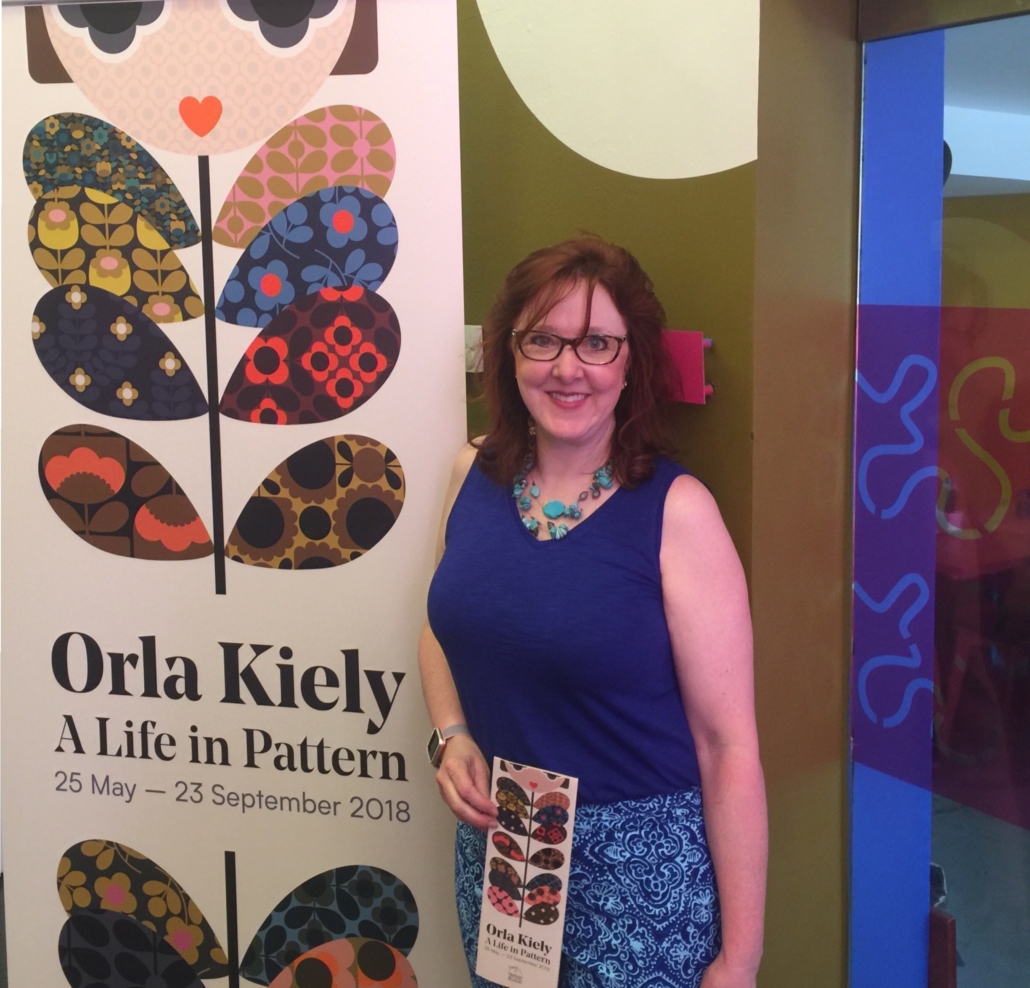
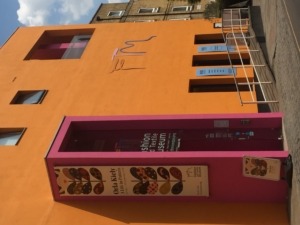 The last time I visited London, I found this wonderful little gem of a museum in the Southwark neighborhood. This visit, they are featuring the work of Orla Kiely, one of Ireland and the UK’s most famous fashion designers, a perfect blend after just completing my trip to Ireland!
The last time I visited London, I found this wonderful little gem of a museum in the Southwark neighborhood. This visit, they are featuring the work of Orla Kiely, one of Ireland and the UK’s most famous fashion designers, a perfect blend after just completing my trip to Ireland!
Orla Kiely studied textile design in Dublin in the early 1980’s and received her MA from the Royal College of Art in 1992. Having grown up in Ireland in the 60’s and 70’s, Orla’s design are influenced by the styles, colors and patterns of that era.

Designs from Orla’s college years
Nature inspires many of Kiely’s repeating patterns. Her “Stem” pattern has become an iconic design, catapulting Kiely into International design success in 2000.

Display of different iterations of Orla Kiely’s Stem pattern.
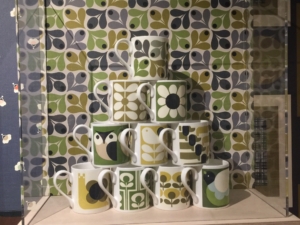
Coffee mug collection featuring Orla’s designs.
Her designs are based in rhythmic and repetitive pattern, now popular in accessories, handbags, wallpaper, and home decor, as well as her seasonal fashion collections.
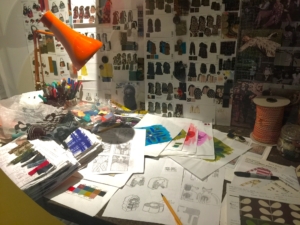
From the desk of Orla Kiely
Changes of scale, coordinating colors (often in a 1970’s palette, including avocado green, harvest gold, orange and chocolate brown), and whimsical, near-abstract depictions of animals are all common elements that make Orla’s designs unique and distinguishable. The exhibition includes over 150 patterns and products and is well worth attending!
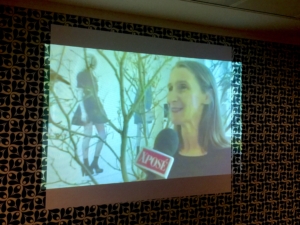
Filmed videos of Orla describing her inspirations, creative process, and collections, as well as footage of her fashion collection engage the audience in a multi media experience.

Christina surveying a display of Orla Kiely handbags
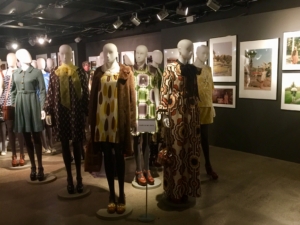




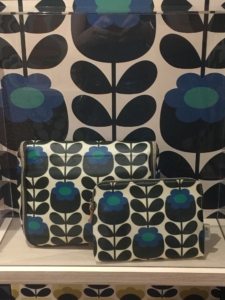
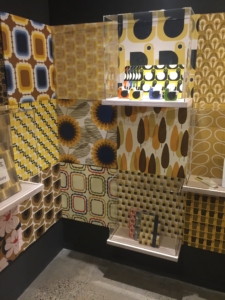

UK Tour Day 1- Royal School of Needlework Curator’s Tour
 I’m a great admirer of England’s RSN and the incredible embroidery pieces produced by their students and tutors. I’ve had the great fortune to visit them twice in the past, most recently in 2016 for theor Stumpwork and Raised Work exhibit. So when planning my current tour, I looked up what is available and found their current exhibit is “Animals in Embroidery”- one of my favorite things to create! Only problem was that the curator’s tour this month occured only at 11 am on the day I arrive from Seattle at 7 am! I thought about it for several weeks and then decided I’d take the risk and sign up, even if timing was tight and I might miss it. Luckily the stars must have been aligned because our flight arrived on time, we were successful with our train connections, and we met the RSN volunteers at the front ‘moat’ gate of Hampton Court Palace at 10:45 am.
I’m a great admirer of England’s RSN and the incredible embroidery pieces produced by their students and tutors. I’ve had the great fortune to visit them twice in the past, most recently in 2016 for theor Stumpwork and Raised Work exhibit. So when planning my current tour, I looked up what is available and found their current exhibit is “Animals in Embroidery”- one of my favorite things to create! Only problem was that the curator’s tour this month occured only at 11 am on the day I arrive from Seattle at 7 am! I thought about it for several weeks and then decided I’d take the risk and sign up, even if timing was tight and I might miss it. Luckily the stars must have been aligned because our flight arrived on time, we were successful with our train connections, and we met the RSN volunteers at the front ‘moat’ gate of Hampton Court Palace at 10:45 am.
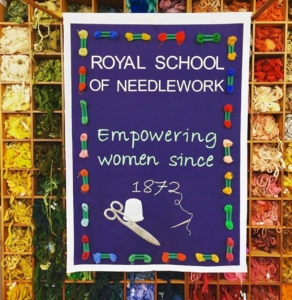 The Royal School of Needlework (RSN) started in the late 1800’s with Queen Victoria as their first patron. Their mission has been to keep the art and techniques of hand embroidery alive and thriving, as well as helping train women (now men too) for employment so they can support themselves and not become destitute They have classes at Hampton Court Palace and other International locations lasting from 1 day to several year programs. They also have rotating exhibitions at their on site location, which can be viewed with a curator’s tour. Book a tour at the Royal School of Needlework here!
The Royal School of Needlework (RSN) started in the late 1800’s with Queen Victoria as their first patron. Their mission has been to keep the art and techniques of hand embroidery alive and thriving, as well as helping train women (now men too) for employment so they can support themselves and not become destitute They have classes at Hampton Court Palace and other International locations lasting from 1 day to several year programs. They also have rotating exhibitions at their on site location, which can be viewed with a curator’s tour. Book a tour at the Royal School of Needlework here!
According to our presenter who is inher second year of the RSN teacher certification program, animals (including birds) are the second most common subject for embroidery (flowers are the most popular.) The display of both student and tutor work includes all sorts of techniques, tied together by the common theme of animals. The techniques include blackwork, needlelace, goldwork, canvas, Jacobean crewel embroidery, whitework, applique, and silk shading.
One piece that caught my eye was a blackwork race horse and rider. The stitches were so tiny- about 3 mm at the longest. To create the shading/shadows, the density of stitch is increased, often by increasing the thread weight. The jockey was done in blackwork techniques, but using colored threads to create contrast. This exquisite piece was given to Her Majesty Queen Elizabeth II, on the occasion of her Diamond Jubilee in 2012.

Cards purchased at the RSN gift shop display a few of the lovely pieces from the “Animals in Embroidery” exhibit.
Silk-shading works beautifully as a technique for animals and birds, as you can make extremely realistic hair/fur and feathers with gradually blending the colors of very fine silk threads. There are many true to life creatures in the exhibit using this technique including rabbits, leopards, chickens, badgers, yaks, flamingos, bats, owls and more! Some might call this a photo- realistic style, but I think it’s so much more than a simple 2D picture. You can’t get the range of texture in photography that you can in stitch.

From the 60,000 piece collection owned by the RSN, this banner has exquisite goldwork with 10 animals included. Can you find them all?
The tour moved then to their workroom where RSN trained embroiderers are working on commission projects. These include both conservation work (repairing historic embroidery to stop the ravages of time) and new bespoke pieces.
As a final treat, we got to the RSN giftshop, where I picked up a few goodies. After flying 9 hours and staying awake through planes, trains and automobiles, we headed back to our hotel in London, to get a well-deserved rest before a late dinner.
If you’re planning a trip to London, make sure to look up the RSN and see if you can take a class or tour. You’ll be glad you did!

The front “moat” entrance of Hampton Court Palace

Actress in period costume working on blackwork embroidery in Hampton Court Palace.

Looking at the back side of the palace (where the school is located).

Magazine I purchased at the RSN store a out the history of the RSN since it moved to Hampton Court.

Second magazine on ecclesiastical embroidery.

New book I found at the RSN store… looks fabulous! A sweet memory to take home and inspire my own projects.
Day 7: The Mill at Avoca Village

Hand loom with weft threads and shuttles
About a month before my trip to Ireland, I get a text from my friend Pam Olney ( @quiltersgarden ) who was currently IN Ireland. She told me I had to add Avoca Handweavers as a stop on my trip. I love getting recommendations from my fiber art friends!
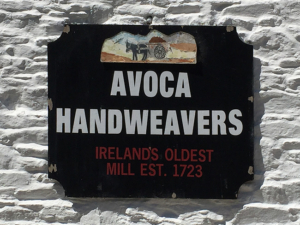
Established in 1723, Avoca is the oldest mill in Ireland still in production. Although it has gone through it’s ups and downs, Avoca Handweavers is now a thriving International business, employing over 800 people. While there are 10 Avoca retail locations around Ireland, the Avoca village location allows you to tour the old mill, the current weaving production facility, as well as having both a wonderful café and giftshop.
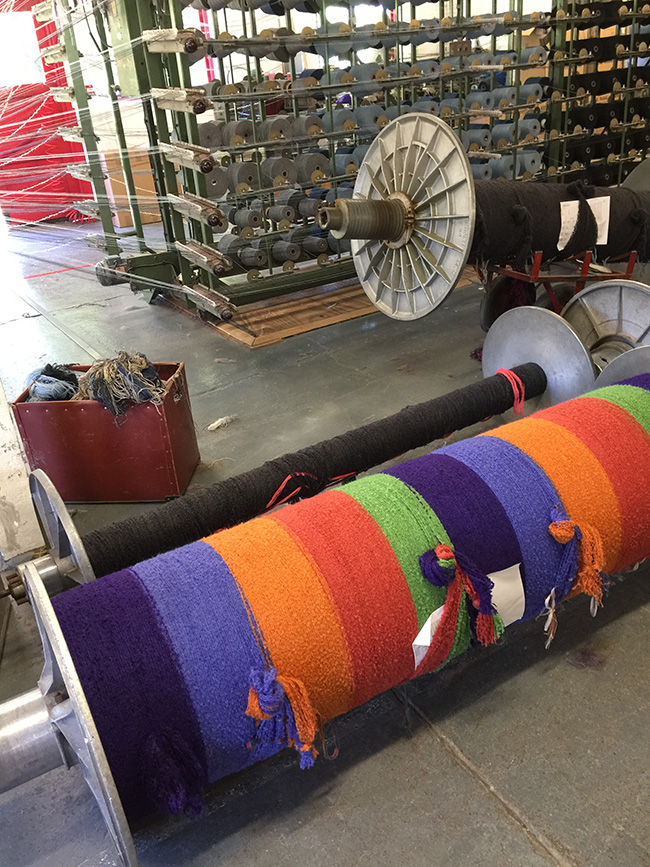
In background, the threads are fed in the correct sequence onto the “Swift” and then onto a “Beam”, like a giant spool for warping the loom. The beam is then lifted onto the loom to be “tied in.” It can take up to 2 days to complete the setting up of a warp.
The mill displays old weaving equipment, educational displays, explanations of the different processes, as well as modern equipment in use.

Beautiful color blending combining warp & weft
Here’s a short video from our visit to the mill showing the power looms, cutting and fringing machines in action:

Antique Irons on display
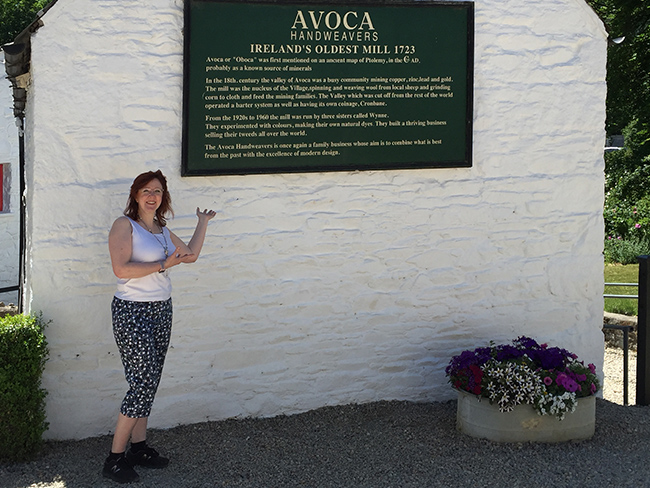
Christina with the Avoca Handweavers sign at Ireland’s Oldest Mill
Day 4 – Game of Thrones Tapestry at the Ulster Museum, Belfast
My guilty pleasure… Game of Thrones (well, Fantasy & Science Fiction overall.) Now, mix that with textile art and I’m in heaven!
Before the final episodes of Game of Thrones were filmed, an army of designers, weavers and embroiderers in Northern Ireland was hard at work.
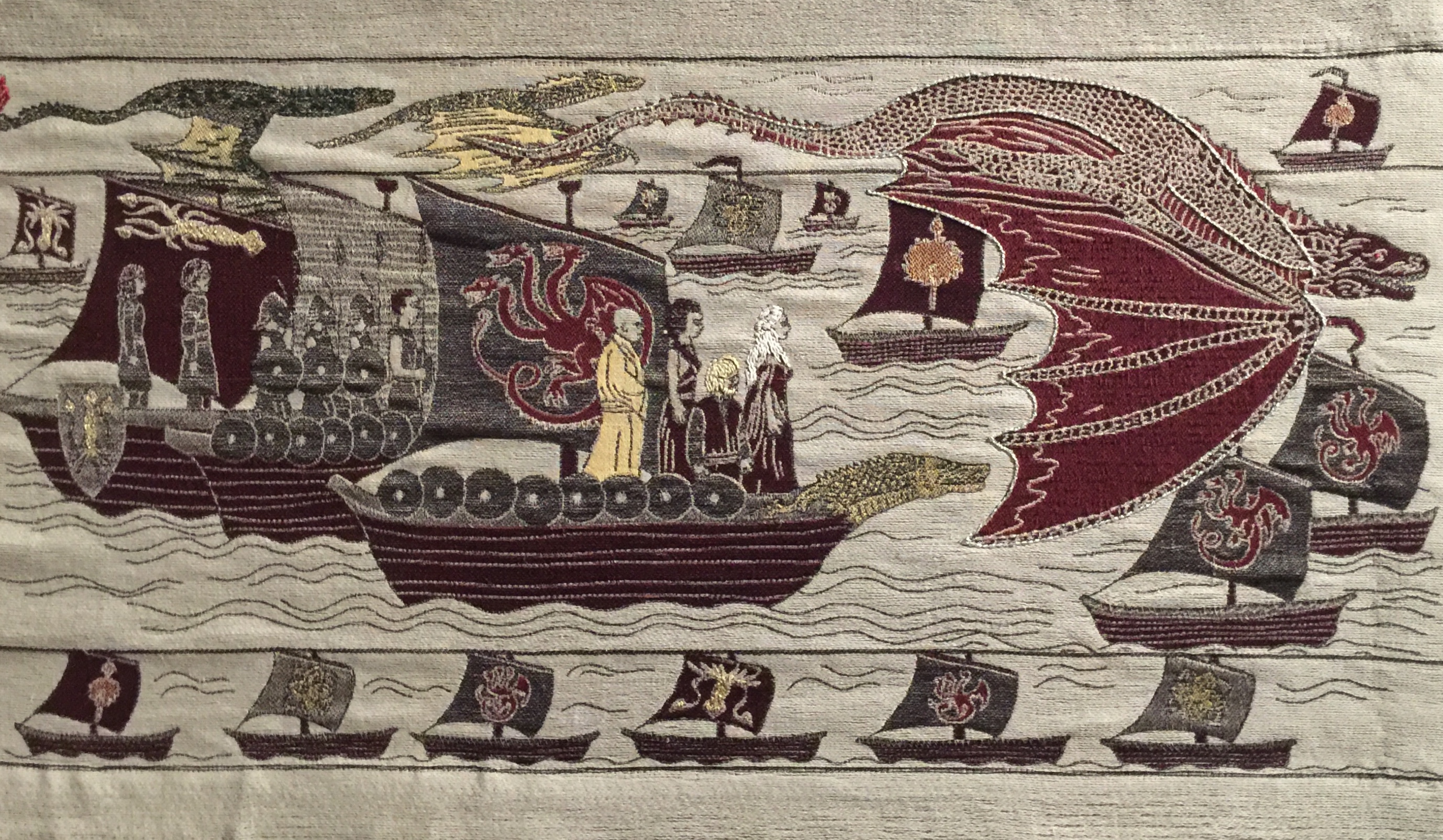 The tapestry was designed by hand by illustrators and color artists Carim Nahaboo, Jacob Merrick-Wolf, and Rob House. The weavers, Juliet Bailey, Franki Brewer, and a team at Dash & Miller in Bristol used a state-of-the-art jacquard loom. The linen thread was provided by Thomas Ferguson Irish Linen in Banbridge, one of the last surviving mills in Northern Ireland, and contains over 250,000 threads placed by hand.
The tapestry was designed by hand by illustrators and color artists Carim Nahaboo, Jacob Merrick-Wolf, and Rob House. The weavers, Juliet Bailey, Franki Brewer, and a team at Dash & Miller in Bristol used a state-of-the-art jacquard loom. The linen thread was provided by Thomas Ferguson Irish Linen in Banbridge, one of the last surviving mills in Northern Ireland, and contains over 250,000 threads placed by hand.
Each episode through season 7 is represented in the 253 foot tapestry. Rather than wait for the final season to be released (Season 8, set to air in 2019), the tapestry develops its own conclusion.

Embroiderer’s working on the Game of Thrones tapestry
After the weaving was complete, delicate hand embroidery added by a team of 30 stitchers at the Ulster Museum adds color, glints of metalics, and detailing to enhance the tapestry. From King Joffrey’s golden crown to Daenerys’ shimmering white and silver hair, blood red weddings, emerald green wildfire, cold-blue White Walkers and jet black ravens, threads of metallic, cotton and silk yarns bring vibrancy and lustre to the story. The embroidered elements are quite simple overall, but bring much to the finished project. Stitches include chain stitch, split stitch, back stitch, running stitch, couching and seed stitch.

Willow dragons made by Bob Johnson, basket maker at the Ulster Folk & Transport Museum
In Belfast’s Ulster Museum where the Tapestry is currently on display, they also have two magnificent Willow dragons soaring above the three story atrium
Click on the video below to view the entire tapestry!

A woman & young girl embroidering linens in County Down early 1900’s.
As well as information about the making of the tapestry, the exhibition included further documentation on the history of the linen industry in Northern Ireland, supplementing what I’d learned in Lisburn.

Dragon Head detail

The process of making the tapestry is described in this video by Northern Ireland’s tourism department:
Day 2- Dublin, Ireland
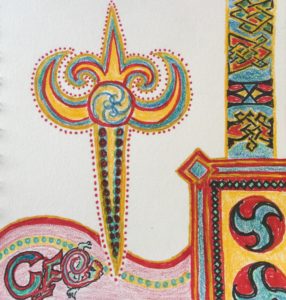
Design inspired by the Book of Kells by Christina Fairley Erickson
We started our day by walking over to Trinity College, to visit the Book of Kells Museum. A beautifully preserved illuminated manuscript created around 800 C.E., the book includes the four books of the gospels- Matthew, Mark, Luke and John.
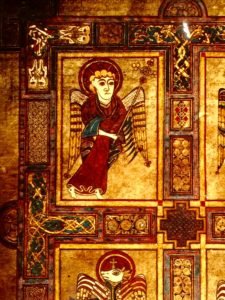
Depiction of Matthew, Book of Kells, folio 27v
The museum hosts incredible displays of many of the intricate illuminated pages, the processes and materials that were used in making the book, as well as information on the few other manuscripts still surviving from about the same period in history. The treasury in the museum displays both the Book of Kells and the Book of Armagh, also from the 800’s.

Symbol of ‘the lion of Mark’, Book of Kells, folio 27v
Due to the delicate nature of the volumes, the Book of Kells is split in two parts, with one section open to an illuminated page and the second open to two of the pages of ancient Medieval Latin script. They change which pages are displayed every three months (and it takes several hours to do it, with all the precautions they have to take!) The Book of Armagh is much smaller in size than the Book of Kells. It contains the New Testament of the Bible in minuscule calligraphic text, without illumination.
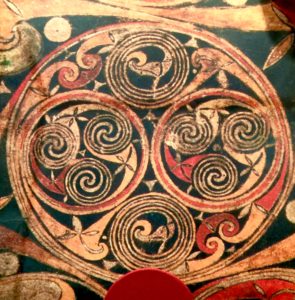
Part of a display at the Book of Kells Museum showing details of circles and swirls along with pieces of jewelry from the same time period with similar Celtic imagery
One thing I found fascinating was the information on the different inks they used… they even had a purple ink- a very rare color in medieval times.
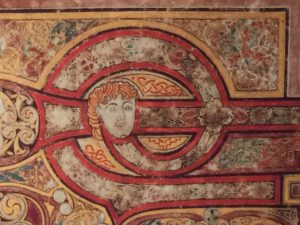
The ‘Chi Rho’ page using the Greek monogram of the name of Christ. Book of Kells, folio 34r
The twisting sinuous Centic knots and designs are masterfully executed- most likely by young monks, 15-19 years old or so, as they would have had the best eyesight. There are also some other details that also lead to this conclusion, such as tiny farcical characters such as two cats overlooking mice fighting over what appears to be a communion wafer!

Here are a few more images to enjoy from this inspiring design source!
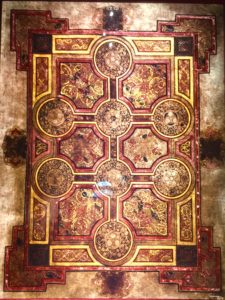
A double-armed cross with eight circles, representing the eight days of Christ’s Passion. Book of Kells, folio 33r
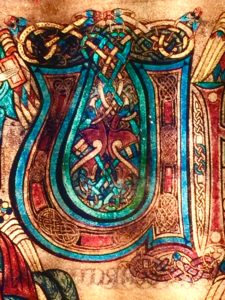

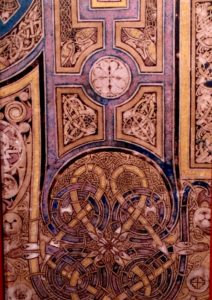
Some of the purple ink is still visible!
If you’d like to see the Book of Kells but aren’t going to make it to Dublin anytime soon, Trinity College has done a fantastic job of scanning the complete book and posting it online. Go to: http://digitalcollections.tcd.ie/home/index.php?DRIS_ID=MS58_003v

